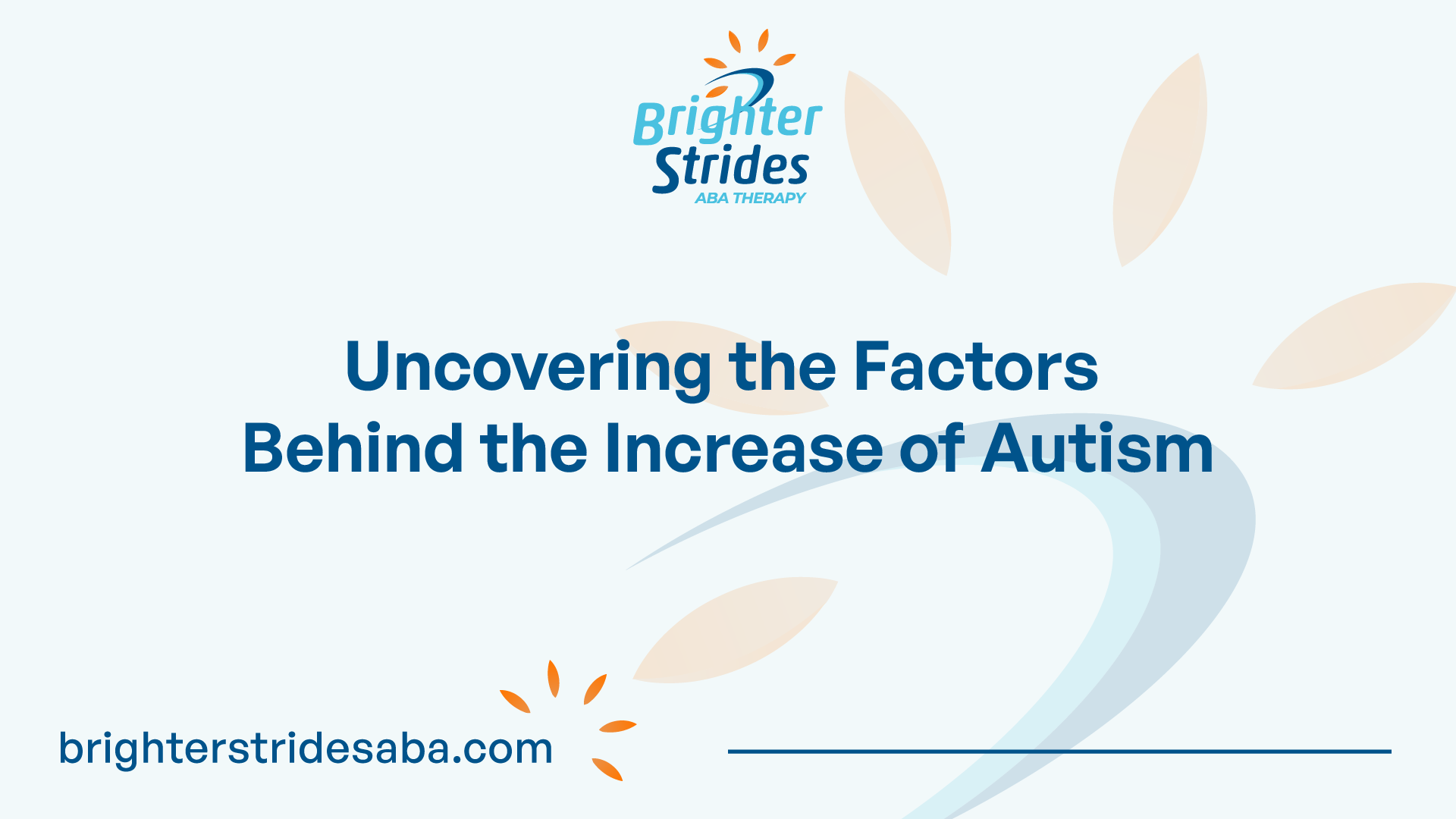Understanding the Rise in Autism Rates
As the prevalence of autism spectrum disorders (ASDs) continues to increase, it is important to delve into the factors behind this rise. To gain a better understanding, let’s explore the current prevalence of autism spectrum disorders and the genetic factors that contribute to vulnerability to ASD.

Current Prevalence of Autism Spectrum Disorders
The current prevalence of autism spectrum disorders is estimated to be 1 in 68 individuals. This means that approximately 1.5% of children in the United States are diagnosed with ASD. The rise in prevalence has been attributed to a combination of increased awareness, changes in diagnostic criteria, and improved screening efforts.
Genetic Factors and Vulnerability to ASD
Advances have been made in identifying genetic variants that can account for the biological vulnerability to ASD. It is now recognized that there is a strong genetic component to autism, with certain genes playing a role in an individual’s susceptibility to developing the disorder.
Recent studies have shown that families with at least one child diagnosed with ASD have a 10% to 19% risk of recurrencThis suggests a hereditary component and highlights the importance of genetic factors in understanding the rise in autism rates.
While specific genes associated with ASD have been identified, it is important to note that the genetic landscape of autism is complex and not fully understood. Multiple genes, each with small effects, are likely to contribute to the development of autism. Researchers continue to investigate the intricate interplay between genetic factors and environmental influences to gain a comprehensive understanding of the rise in autism rates.
Understanding the current prevalence of autism spectrum disorders and the genetic factors that contribute to vulnerability provides a foundation for further research and intervention strategies. By continuing to explore the complex nature of ASD, we can strive for earlier diagnosis, effective interventions, and improved outcomes for individuals with autism and their families.
Theories on the Pathogenesis of Autism
To better understand the factors contributing to the increase in autism rates, researchers have explored various theories regarding the pathogenesis of autism spectrum disorder (ASD). Two prominent theories in this area are the prenatal origins of ASD and gender-based theories of autism.
Prenatal Origins of ASD
According to some researchers, the pathogenesis of ASD may begin during prenatal life. This theory suggests that certain prenatal factors, such as genetic mutations, maternal health conditions, or exposure to environmental toxins, may influence the development of ASD in the fetus.
It is important to note that the exact causes and mechanisms behind the prenatal origins of ASD are still being investigated. Ongoing research aims to identify specific genetic and environmental factors that may contribute to the development of ASD during prenatal life.
Gender-Based Theories of Autism
Several gender-based theories have been proposed to explain the differences in autism prevalence between males and females. One such theory is the female protective effect, which suggests that girls and women are biologically protected from developing autism [2]. It is believed that certain genetic or hormonal factors may contribute to this protective effect.
On the other hand, the extreme male brain theory proposes that autism is an exaggeration of systematic sex differences in ways of thinking. According to this theory, individuals with autism exhibit more pronounced male-typical cognitive traits, such as a focus on systems and patterns, rather than empathizing with others.
While these gender-based theories provide valuable insights into the complex nature of autism, it’s important to remember that they are still subject to ongoing research and debate. Further studies are needed to fully understand the interplay between genetics, hormones, and brain development in relation to autism.
By exploring theories such as the prenatal origins of ASD and gender-based theories, researchers aim to unravel the underlying factors contributing to the rise in autism rates. These theories provide a framework for future research and may ultimately lead to a better understanding of the causes and potential interventions for individuals with autism spectrum disorder.
Environmental Influences on Autism
While genetics play a significant role in the risk of developing autism spectrum disorder (ASD), it is important to consider the potential impact of environmental influences on the increasing prevalence of autism. Researchers have been exploring various factors, including toxins and environmental factors, as well as prenatal and postnatal risk factors, to gain a better understanding of their potential association with ASD.
Toxins and Environmental Factors
There is growing interest in the potential involvement of toxins in the environment in relation to the increase in autism rates. Although genetics strongly influence the risk of developing ASD, they do not account for all instances of autism. Research conducted by Autism Speaks focuses on understanding how environmental influences interact with genetic susceptibility, aiming to guide prevention and improve diagnosis and treatment of autism [3].
Certain prenatal exposures to chemicals have been associated with an increased risk of autism. For example, studies suggest that exposure to chemicals like thalidomide and valproic acid during pregnancy may elevate the risk of autism [3]. However, it is important to note that these associations do not imply causation, and further research is needed to establish a clearer understanding of the relationship between environmental toxins and autism.
Prenatal and Postnatal Risk Factors
Environmental risk factors for autism include various influences, both during pregnancy and after birth. Prenatal risk factors can include parental age at conception, maternal nutrition, infections during pregnancy, and prematurity. These factors have been suggested to potentially contribute to the development of autism [3]. It is important to note that individual susceptibility to these factors can vary, and not all individuals exposed to these risk factors will develop autism.
Postnatal risk factors, such as exposure to certain chemicals, pollutants, or toxins during early childhood, have also been explored in relation to autism. However, the exact mechanisms through which these factors may affect the development of autism are still under investigation.
Understanding the potential environmental influences on autism is an ongoing area of research. The goal is to identify modifiable risk factors and develop strategies to reduce their impact, particularly in individuals who may be genetically predisposed to ASD. By gaining a better understanding of the interplay between genetics and the environment, we can strive to improve prevention, diagnosis, and treatment approaches for individuals with autism spectrum disorder.
Factors Contributing to Increased Awareness
The rise in autism rates can be attributed to various factors, including increased awareness and changes in diagnostic practices. In this section, we will explore two significant factors that have contributed to the increased awareness of autism: diagnostic criteria and observational diagnosis, as well as policy changes and screening efforts.
Diagnostic Criteria and Observational Diagnosis
Unlike other medical conditions with specific diagnostic tests, autism spectrum disorder (ASD) is primarily diagnosed through observations of a person’s behavior. Diagnostic criteria for ASD have evolved over time, leading to changes in the number of individuals diagnosed with autism.
As awareness of autism has grown, clinicians and researchers have refined the diagnostic criteria, resulting in better identification of individuals on the autism spectrum. The criteria now encompass a broader range of behaviors and characteristics, allowing for more accurate diagnosis and inclusion of individuals who may have previously gone undiagnosed.
The shift from a narrow definition of autism to a more inclusive one has contributed to the increase in autism rates. By recognizing a wider range of behaviors associated with ASD, more individuals can receive appropriate support and interventions.
Policy Changes and Screening Efforts
Policy changes and increased efforts in screening for autism have also played a significant role in the rising rates of diagnosis. Organizations, such as the American Academy of Pediatrics, have recommended routine screening for autism during pediatrician visits, leading to earlier identification and intervention for children on the autism spectrum.
The implementation of policies advocating for increased screening has helped identify children who may have otherwise gone undiagnosed. This has been especially beneficial for underrepresented groups, such as African-American and Hispanic children, who historically had lower rates of autism diagnosis due to lack of access to services. Widespread screening initiatives have improved detection and contributed to the rise in overall prevalence.
Moreover, the emphasis on early intervention and support for individuals with autism has prompted healthcare providers and educators to prioritize screening efforts. By identifying autism at an earlier age, appropriate interventions and support services can be implemented, enhancing the quality of life for individuals on the autism spectrum.
The combination of changes in diagnostic criteria, observational diagnosis practices, policy changes, and screening efforts has led to increased awareness and identification of autism. As a result, more individuals are receiving the necessary support and services to thrive. However, it’s important to note that the rise in autism rates is not solely due to an increase in the prevalence of the condition itself, but also reflects the progress made in recognizing and addressing the needs of individuals on the autism spectrum.
Rising Trends in Autism Diagnosis
As the prevalence of autism spectrum disorder (ASD) continues to rise, it is important to explore the factors contributing to this increase. In this section, we will focus on two aspects: ethnic disparities in diagnosis rates and state variations in prevalence rates.
Ethnic Disparities in Diagnosis Rates
Recent reports indicate that rates of autism in Black and Hispanic children have surpassed rates in white children for the first time, according to the CDC. This suggests that there are ethnic disparities in the diagnosis rates of autism.
Historically, African-American and Hispanic children have had lower rates of autism diagnosis due to factors such as limited access to healthcare services and cultural differences in seeking help [5]. However, with the widespread efforts in screening and improved access to services, there has been an improvement in the detection of autism in these groups, which has contributed to the overall rise in prevalence.
It is essential to address these disparities and ensure equal access to screening, diagnosis, and support services for all ethnic groups. By doing so, we can ensure that every child with autism receives the necessary interventions and support to thrive.
State Variations in Prevalence Rates
Autism prevalence rates vary across different states in the United States. For example, the prevalence of autism among 8-year-old children ranges from 2.3% in Maryland to 4.5% in California. These variations can be attributed to differences in screening and treatment approaches, as well as access to healthcare services.
State-specific policies, resources, and initiatives play a significant role in determining the prevalence rates of autism. States with comprehensive screening programs and early intervention services may have higher rates of diagnosis compared to those with limited resources and support systems.
It is crucial for states to prioritize the development of effective screening programs and ensure access to appropriate interventions for individuals with autism. By addressing the state-specific factors contributing to variations in prevalence rates, we can work towards providing equal opportunities and support for individuals with autism across the country.
Understanding the rising trends in autism diagnosis involves not only examining ethnic disparities and state variations but also considering the broader factors contributing to the increase. Growing awareness, advocacy efforts, improved screening practices, and suspected environmental factors are all important elements to consider. By further exploring these factors, we can continue to enhance our understanding of autism and ensure that individuals with autism receive the necessary support and resources they need.
Evolution of Autism Understanding
Over the years, our understanding of autism has evolved significantly. From historical views that attributed it to external factors to the modern understanding of Autism Spectrum Disorder (ASD) as a complex neurodevelopmental condition, the journey of comprehending autism has been transformative.
Historical Views and Diagnostic Revisions
In the past, autism was often misunderstood and attributed to various factors unrelated to its true nature. One notable theory was the “refrigerator mother” theory, which suggested that autism was caused by cold and distant parenting. However, in 1980, the third edition of the Diagnostic and Statistical Manual of Mental Disorders (DSM) changed the landscape by recognizing that autism had a biological basis affecting the brain and development. This pivotal shift moved away from blaming parents and focused on understanding the neurological aspects of the condition.
Subsequent revisions of the DSM further refined the understanding of autism. The DSM-IV, published in 1994, was the first edition to describe autism as a spectrum, encompassing conditions such as Asperger’s disorder and Rett’s syndrome. This expanded definition allowed for better recognition, diagnosis, and treatment of the various types of autism that individuals may experience.
Modern Understanding of Autism Spectrum Disorder
In 2013, the DSM-V was released, solidifying our modern understanding of autism. It introduced the term “Autism Spectrum Disorder” (ASD), which encompasses a range of conditions characterized by persistent impairments in social communication and interaction, as well as restricted and repetitive patterns of behavior. This edition of the DSM reflects the current understanding of autism as a complex spectrum disorder that can manifest in various ways [6].
The DSM-V’s definition of ASD has been crucial in facilitating comprehensive diagnosis and support for individuals on the autism spectrum. By recognizing the diverse range of symptoms and experiences, the DSM-V has contributed to a more consistent understanding of autism within the medical community and society as a whole. This understanding has paved the way for research, interventions, and support systems aimed at improving the lives of individuals with autism.
As our understanding of autism continues to grow, it is important to recognize the ongoing research and advancements in the field. By staying informed and embracing the evolving knowledge, we can continue to support individuals with autism and promote inclusivity and acceptance in our communities.
References
- [1]: https://www.ncbi.nlm.nih.gov/pmc/articles/PMC9923899/
- [2]: https://www.spectrumnews.org/features/legacy-special-reports/theories-of-autism/
- [3]: https://www.autismspeaks.org/autism-environmental-factors
- [4]: https://www.healthline.com/health-news/autism-rates-in-children-reach-new-highs-experts-explain-why
- [5]: https://www.scientificamerican.com/article/the-real-reasons-autism-rates-are-up-in-the-u-s/
- [6]: https://theplaceforchildrenwithautism.com/autism-blog/the-evolution-of-the-autism-diagnosis

 We've just released an article!
Check out our blog!
We've just released an article!
Check out our blog!



